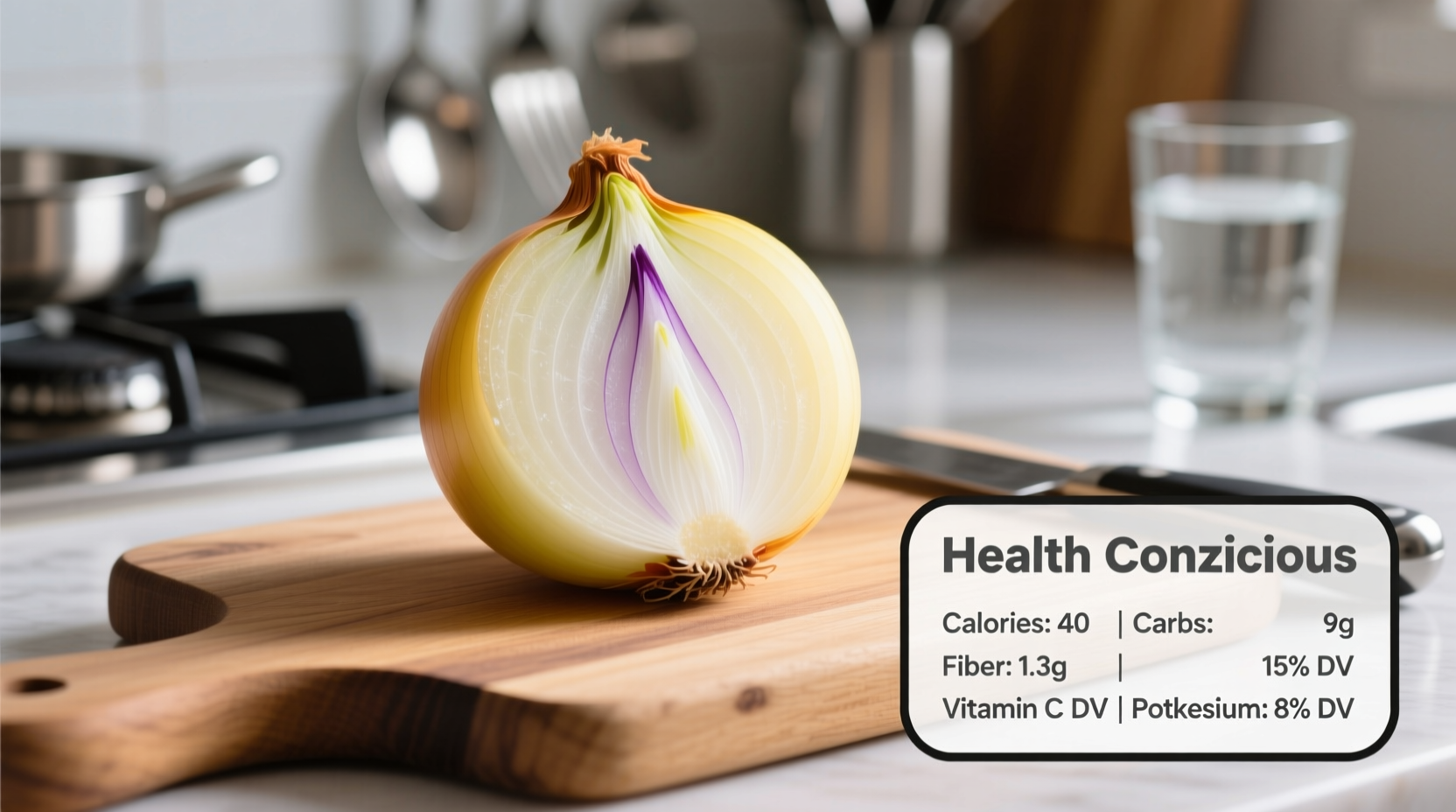Understanding the precise nutritional value of common ingredients is essential for anyone tracking their dietary intake. Whether you're meal prepping, managing weight, or simply curious about what you're eating, knowing exactly how many calories are in one onion helps you make informed food choices without sacrificing flavor.
What You'll Actually Use: Onion Calorie Facts at a Glance
When you're standing in the kitchen deciding whether to add that extra onion to your stir-fry or salad, you need practical information—not just numbers. Here's what matters for real-world cooking and eating:
| Onion Type | Size (Approx.) | Calories | Carbohydrates | Fiber |
|---|---|---|---|---|
| Yellow Onion (medium) | 110g / 3.9oz | 44 | 10g | 1.9g |
| Red Onion (medium) | 110g / 3.9oz | 42 | 9.8g | 1.8g |
| White Onion (medium) | 110g / 3.9oz | 45 | 10.3g | 2.0g |
| Green Onions (scallions) | 100g / 3.5oz | 32 | 7.3g | 2.6g |
Data source: USDA FoodData Central (2023 update) fdc.nal.usda.gov
How Onion Size Affects Your Calorie Count
"One onion" isn't a standardized measurement, which explains why people get confused about onion calories. Professional chefs and nutritionists use weight measurements for accuracy, but home cooks typically work with visual cues:
- Small onion: About the size of a golf ball (80g) = 32 calories
- Medium onion: Roughly the size of a tennis ball (110g) = 44 calories
- Large onion: Comparable to a baseball (150g) = 60 calories
- Jumbo onion: Larger than a tennis ball (200g+) = 80+ calories
When recipes call for "one onion," they typically mean a medium onion unless specified otherwise. If you're tracking calories precisely, weighing your onion provides the most accurate count.

Practical Cooking Applications: Making Onions Work for Your Goals
Knowing the calorie count is just the beginning—understanding how onions function in your meals determines their real nutritional impact:
Raw vs. Cooked: Does Preparation Change Calories?
Surprisingly, cooking onions doesn't significantly alter their calorie content. Whether raw in salads or caramelized in sauces, the calorie count remains consistent per weight. What changes is water content and volume:
- Raw onions: Maintain their full volume and crisp texture
- Sautéed onions: Reduce to about 50% of original volume as water evaporates
- Caramelized onions: Reduce to approximately 25% of original volume after extended cooking
This volume reduction explains why a small amount of caramelized onions can seem more substantial—they've concentrated the same nutrients into less physical space.
Onions in Meal Planning: Smart Strategies
Maximize flavor while minimizing calorie impact with these professional techniques:
- The 50/50 blend: Mix half onion with half mushrooms to maintain texture while reducing overall calories
- Layering technique: Start with a small amount of onion as flavor base, then add volume with lower-calorie vegetables
- Strategic placement: Use stronger-flavored red onions sparingly where their intense flavor means you need less
- Freezing method: Freeze chopped onions in ice cube trays with water for portion-controlled additions to soups and stews
Health Benefits Beyond Calories: Why Onions Deserve a Place on Your Plate
While the calorie count matters for tracking purposes, onions offer significant nutritional advantages that make them valuable beyond simple calorie counting:
- Vitamin C boost: One medium onion provides about 15% of your daily vitamin C needs
- Fiber content: Contributes to digestive health and helps you feel full longer
- Antioxidant power: Rich in quercetin, particularly in red onions, which has anti-inflammatory properties
- Blood sugar support: Contains compounds that may help regulate blood glucose levels
According to research published in the Journal of Agricultural and Food Chemistry, the sulfur compounds in onions may contribute to cardiovascular health when consumed regularly as part of a balanced diet. These benefits exist regardless of whether you're counting calories or not.
Common Misconceptions About Onion Calories
Several myths persist about onion nutrition that can lead to unnecessary dietary restrictions:
- Myth: Onions are high in sugar and should be avoided on low-carb diets
Reality: While onions contain natural sugars, a medium onion has only about 5g of sugar—less than half an apple—and provides valuable fiber that slows sugar absorption - Myth: Cooking onions makes them significantly higher in calories
Reality: The calorie count remains consistent by weight; any perceived increase comes from added fats during cooking, not the onion itself - Myth: All onion varieties have dramatically different nutritional profiles
Reality: While red onions contain slightly more antioxidants, the calorie and basic nutrient differences between varieties are minimal
Putting It All Together: Your Onion Strategy
Whether you're tracking every calorie or simply eating mindfully, onions represent one of the most versatile, flavorful, and nutritionally beneficial ingredients you can add to your diet. Their low calorie count combined with significant nutritional benefits makes them an excellent choice for virtually any eating pattern.
When planning meals, consider onions as flavor amplifiers rather than just another ingredient. A small amount can transform simple dishes, allowing you to reduce higher-calorie components while maintaining satisfaction. This strategic approach delivers maximum flavor with minimal calorie impact—a win-win for health-conscious eaters.











 浙公网安备
33010002000092号
浙公网安备
33010002000092号 浙B2-20120091-4
浙B2-20120091-4